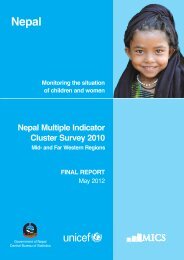Chapter 15 Internal Migration in Nepal - Central Bureau of Statistics
Chapter 15 Internal Migration in Nepal - Central Bureau of Statistics
Chapter 15 Internal Migration in Nepal - Central Bureau of Statistics
Create successful ePaper yourself
Turn your PDF publications into a flip-book with our unique Google optimized e-Paper software.
In 1991, the total volume <strong>of</strong> the <strong>in</strong>ter-regional migration was 1,418,206, which was bigger by<br />
379,344 migrants than <strong>in</strong> 1981 (Table <strong>15</strong>.11). This represented an annual growth rate <strong>of</strong> 3.1 per<br />
cent. Some significant differences have been noticed <strong>in</strong> the <strong>in</strong>-and out-migration pattern between<br />
1981 and 1991. Out-migration from the eastern mounta<strong>in</strong> was the second most dom<strong>in</strong>ant<br />
phenomenon from the eastern hill <strong>in</strong> 1981. The scenario <strong>of</strong> out-migration changed <strong>in</strong> 1991. The<br />
magnitude <strong>of</strong> out-migration was dom<strong>in</strong>ated by eastern (22.3%), western (21.6%) and central hill<br />
(21.6%). Even mid-western and far -western hill exceeded other regions <strong>in</strong> the total volume <strong>of</strong> outmigration<br />
<strong>in</strong> 1991.<br />
Out-migrants from eastern mounta<strong>in</strong> heavily concentrated <strong>in</strong> eastern Tarai (71.9%) and eastern<br />
hill (<strong>15</strong>.8). This is the first trajectory. From the central mounta<strong>in</strong>, the trajectory was towards<br />
central hill (62.4%) and central Tarai (30%).<br />
In 2001, the total volume on <strong>in</strong>ter -regional migration was 2,047,350 persons with a gross<br />
migration <strong>of</strong> twice this number (4,094,700). Like <strong>in</strong> the earlier decades, the migration streams<br />
from one region to another were directed towards their own neighbour<strong>in</strong>g regions (Table <strong>15</strong>.12).<br />
<strong>Migration</strong> from eastern mounta<strong>in</strong> was directed towards eastern hill (21,887), central hill (16,589)<br />
and eastern Tarai (86,028). <strong>Migration</strong> from the central mounta<strong>in</strong> was directed to central hill<br />
(59,282) and central Tarai (<strong>15</strong>,123). Similarly, the dest<strong>in</strong>ation areas for the out-migrants <strong>of</strong> midwestern<br />
and far-western mounta<strong>in</strong> were mid-western and far-western hill and Tarai. The stream <strong>of</strong><br />
out-migration from far-western mounta<strong>in</strong> to far-western hill (59,282) and far-western Tarai<br />
(45,670) was much bigger than <strong>in</strong> other regions.<br />
<strong>Migration</strong> from the eastern hill was directed, to a lesser extent, to eastern (12,499) and central<br />
mounta<strong>in</strong> (8,237) and, to a greater extent, to central hill (55,212), eastern Tarai (298,929), and<br />
central Tarai (26,667). From central hill, the migration stream was dom<strong>in</strong>antly directed to central<br />
Tarai (99,563) and was spread moderately to central mounta<strong>in</strong> (8,237), eastern hill (6,213),<br />
western hill (<strong>15</strong>,490) and eastern (18,458), western (12,706), mid -western (6,659) and far -western<br />
Tarai (5,671). <strong>Migration</strong> from western hill was heavily concentrated <strong>in</strong> central hill (66,459) and<br />
central (106,791), western (242,852) and mid-western Tarai (29,071). Mid-western to midwestern<br />
Tarai (96,355) and far-western hill to far -western Tarai (162,316) were the dom<strong>in</strong>ant<br />
migration streams between neighbour<strong>in</strong>g regions.<br />
Like <strong>in</strong> the preced<strong>in</strong>g decades , out-migration from five regions <strong>of</strong> Tarai was directed more to the<br />
eastern (55,798) and central hill (74<strong>15</strong>2). Tarai to Tarai migration through sub-regions has been<br />
moderate with relatively more concentration <strong>in</strong> central (29,008), western (13,942) and far -western<br />
Tarai (17,797).<br />
138
















